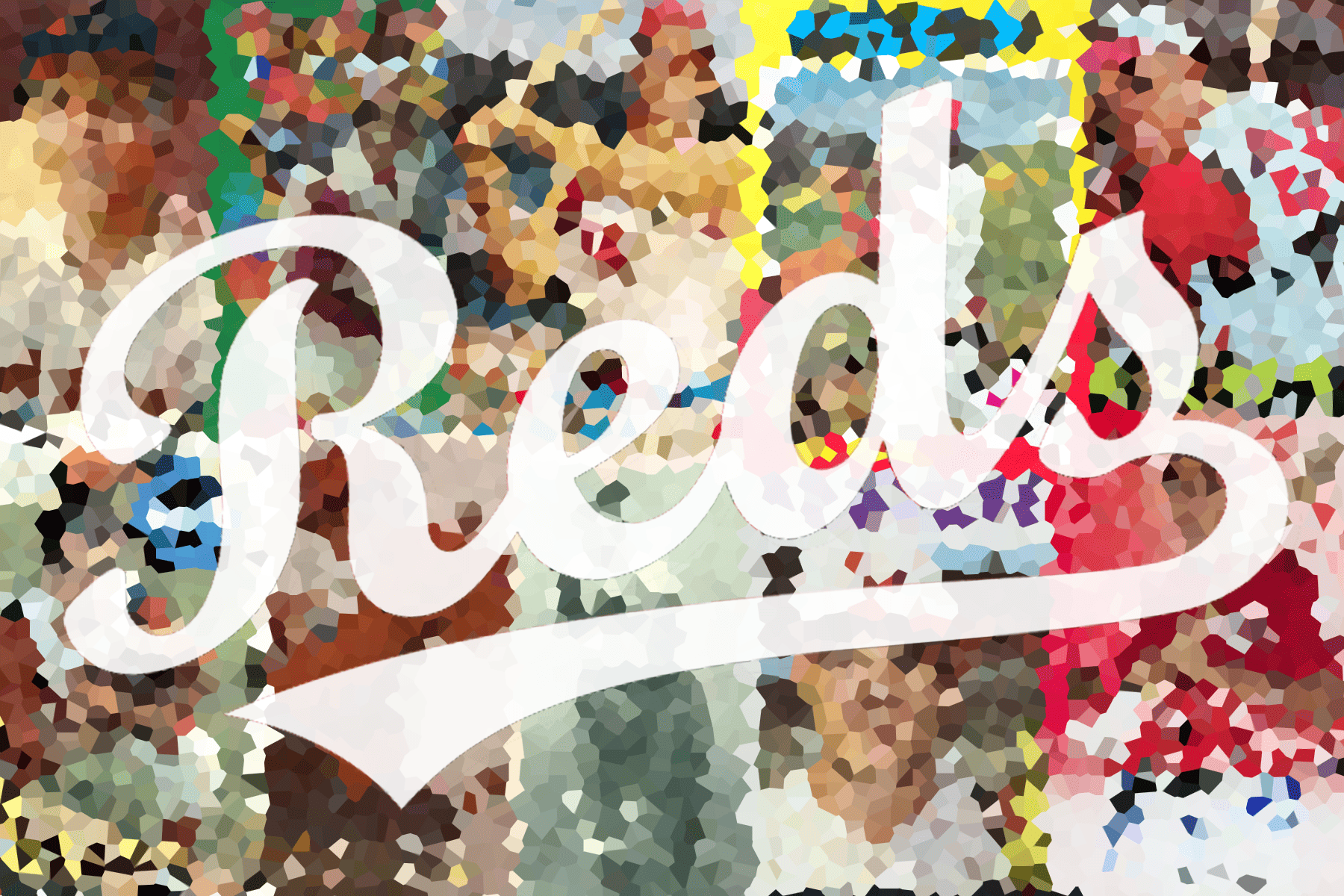[sc name=”ad-250×250″][/sc]
In the rich narrative of Major League Baseball, few franchises can boast a history like that of the Cincinnati Reds. Their storied legacy spans over a century, and collecting Cincinnati Reds cards is a reflection and celebration of that legacy.
Established in 1881 as the Cincinnati Red Stockings, the team’s moniker has undergone subtle changes over the years. The team settled on the iconic “Reds” name in 1890, with a brief stint as the “Redlegs” in the mid-50s. They’ve won the World Series five times, with an all-time winning record of nearly .600.
The Reds first championship came in 1919 – a victory over the Chicago White Sox in what became the “Black Sox” World Series. Often forgotten about that World Series is the fact that the Reds weren’t just easy outs. Before the series, statistically they were equals to Chicago, even boasting a superior regular season record. Future World Series victories came sporadically across the decades, with the peak being the dominant Big Red Machine of the 1970s. The team’s final championship, to date, was in 1990.
Beyond the statistics and championships, the Cincinnati Reds have become an integral part of the fabric of the city. The Reds have been a source of joy, inspiration, and, at times, heartbreak, forging a unique bond between the team and its passionate supporters.
10. Bucky Walters
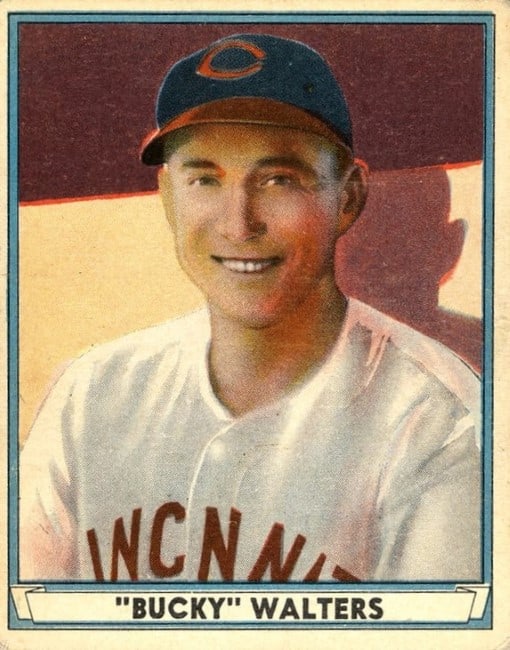
Player History
From 1938 to 1948, Bucky Walters dominated as a right-handed pitcher. Originally a third baseman, Walters debuted in the majors with Philadelphia in 1934, before the Reds acquired him in 1938. He wasted no time showcasing his prowess, earning four All-Star selections during his first four full seasons in Cincinnati.
The pinnacle of Walters’ career with the Reds came in 1939. He secured the pitching Triple Crown by leading the league in wins, strikeouts, and ERA, and the NL MVP award – a rare honor for a pitcher. Walters continued his dominance on the mound, consistently ranking among the league leaders in wins and innings pitched. His remarkable durability was also evident in his four 20-win seasons.
Walters played a pivotal role in the Reds securing a National League pennant in 1939 ,and the team’s second World Series win in 1940. In a pivotal Game 6, he pitched a complete-game shutout, securing the championship for the Reds. This triumph marked the franchise’s first World Series title in 21 years.
Over his illustrious Reds career, Walters amassed 160 wins, leaving an indomitable legacy as one of the most dominant pitchers in the team’s history. He later went on to manage the team from 1948-1949.
In 2009, the Veterans Committee considered Bucky Walters for inclusion in the Baseball Hall of Fame during an initiative to reevaluate pre-World War 2 players. However, he hasn’t yet been chosen for baseball’s highest honor.
Best Cincinnati Reds baseball card: 1941 Play Ball Bucky Walters #3
The 1941 Play Ball set is famous on its own – the image is actually a colorized version of his 1940 Play Ball Cincinnati Reds card – but this card came during Walters’ most successful years. This card costs around $50-$100 for a PSA 5 or PSA 6.
9. Ted Kluszewski
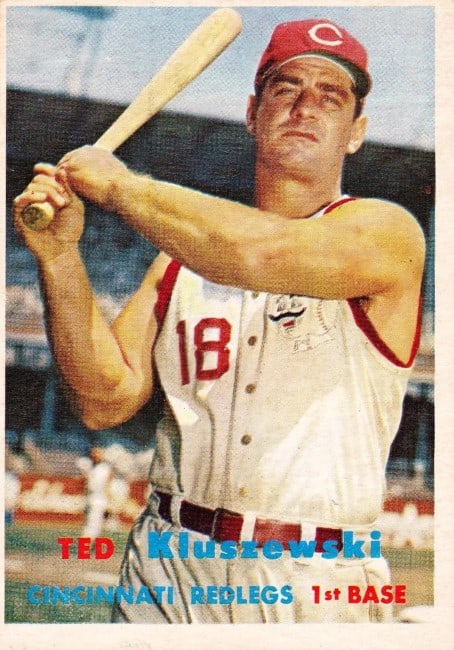
Player History
Ted Kluszewski, a behemoth of a first baseman, played for the Reds from 1947 to 1957. Kluszewski’s physical prowess and intimidating presence in the batter’s box became emblematic of his impact on the Reds’ lineup. Standing at 6 feet 2 inches and boasting bulging biceps, he earned the nickname “Big Klu,” a moniker that resonated with both teammates and opponents alike.
Kluszewski’s offensive prowess became the cornerstone of the Reds’ success in the early 1950s. With a distinctive sleeveless jersey showcasing his muscular arms, he terrorized opposing pitchers with his powerful swing. He was also tough to strike out, with a strikeout percentage of 5.4% during his tenure with Cincinnati.
In 1954, Kluszewski had a season for the ages, belting 49 home runs and amassing an impressive 141 RBIs. His offensive onslaught earned him a second-place finish in the National League MVP voting. He finished in the top 10 of MVP voting two more times.
Individual achievements weren’t the slugger’s only contributions: He played a vital role in leading the Reds to two National League pennants in 1949 and 1956. Despite falling short in the World Series both times, Kluszewski’s presence in the lineup provided a formidable offensive foundation. He also made the All-Star team four consecutive times between 1953-1956.
A back injury effectively ended Kluszewski’s dominance after the 1957 season, but fans of the Reds fondly remember “Big Klu” as a powerhouse hitter whose imposing figure made him a force in the Reds lineup.
Best Cincinnati Reds baseball card: 1957 Topps Ted Kluszewski #165
This card is everything that defined Ted Kluszewski in his best years – the power and the presence in the middle of the Reds lineup. The card itself has excellent coloring that makes the red of his jersey and the text pop, and came during an excellent decade for Topps cards. This card is around $50-$100 in excellent to near-mint condition.
8. Edd Roush
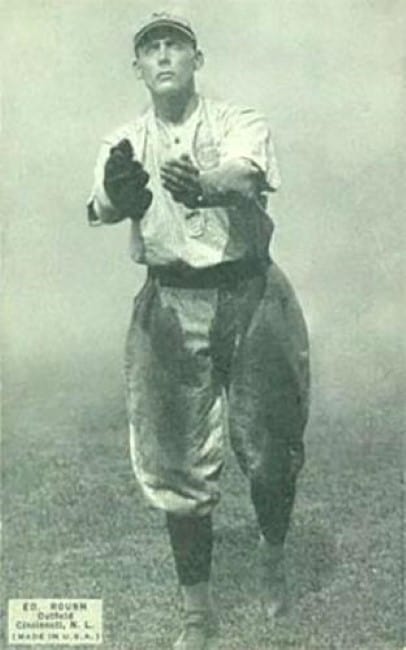
Player History
Outfielder Edd Roush etched his legacy in Cincinnati Reds’ history during his tenure with the team from 1916 to 1926, and a brief return in 1931. Known for his skills in the outfield and a reliable bat, he maintained a remarkable .339 batting average with the Reds. His ability to make contact contributed significantly to the team’s offensive firepower.
In 1917 – Roush’s first full season with the Reds – he hit .341 and beat Rogers Hornsby for the National League batting title. He also finished third in the league in hits, only four behind the league leader. In 1918, Roush nearly won another batting title, hitting .333 and missing the award by two points. He also led the league in OPS that season, with .823.
In 1919, Roush won his second batting title – hitting .321 – and was part of the Reds first World Series win. Ironically, that was his lowest batting average during his time with the Reds. He scored six runs and drove in seven runs in the eight game series.
Edd Roush had a reputation as a quick defender who could run down a ball better than anyone. “Eddie used to take care of the whole outfield, not just center field. He was far and away the best outfielder I ever saw,” said his teammate, Heinie Groh.
Roush’s vicious contract negotiations with ownership, which led to numerous hold-outs, overshadowed his later seasons with Cincinnati. It wasn’t a surprise for players and coaches who knew Roush – he was known for being “feisty.”
By 1926, the Reds underwent a transition, and Roush found himself traded to the New York Giants. His departure marked the end of an era for Roush in Cincinnati, but his impact on the team’s history was lasting. In his brief return in 1931 at the age of 38, Roush was fourth on the team in hitting.
Edd Roush was inducted into the Baseball Hall of Fame in 1962.
Best Cincinnati Reds baseball card: 1925 Exhibits Edd Roush
Roush’s years in Cincinnati didn’t include any major baseball card releases. His playing career was in a gap between the T200 baseball card sets of the 1910s and Goudy sets of the 1930. As a result, many of his cards were from regional food or tobacco cards. His best Cincinnati Reds card is the 1922 American Caramel E120 series, which features an ethereal shot of Roush leaning to catch a pop fly. Like many cards of the time, photography was uncommon. Card companies later reused the same image on his equally-famous 1925 Exhibits card, attributed to his time with the New York Giants. The high grade reported by PSA is a PSA 5, and these low-grade versions run $50-$150.
7. Tony Perez
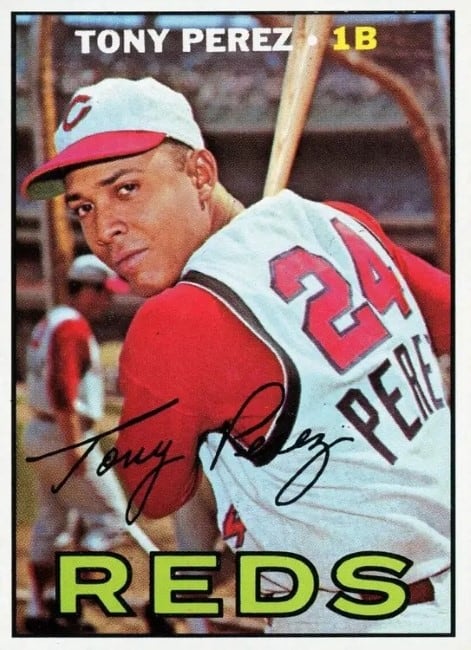
Player History
Atanacio “Tony” Perez, affectionately nicknamed “Big Dog” by fans, embodied the spirit of the Cincinnati Reds during his 17-year tenure with the team (1964-1980). Beyond his statistics, Perez became a beloved figure, earning the title of “The Mayor of Riverfront Stadium” for his leadership and community involvement.
Immediately, Perez established himself as one of baseball’s premier run producers. He was named to his first All-Star team in 1967, a year in which he drove in 102 runs. He averaged over 100 RBIs per season from 1970 to 1976, a period coinciding with the rise of the legendary “Big Red Machine.” This powerhouse lineup, featuring stars like Pete Rose and Johnny Bench, dominated the National League, winning four pennants and two World Series titles (1975, 1976). Perez showcased his clutch hitting in numerous postseason moments, including a game-winning home run in the 1975 World Series.
Throughout his Reds career, Perez amassed impressive accolades. He earned seven All-Star selections, two World Series rings, and the 1970 Silver Slugger Award. He retired with 2,762 hits and 364 home runs, solidifying his place as one of the greatest first basemen in franchise history. His 1,170 RBIs with the Reds rank second only to Johnny Bench.
Beyond statistics, Perez’s leadership and character resonated with fans and teammates alike. He was known for his work ethic, sportsmanship, and commitment to the Cincinnati community.
Tony Perez was inducted into the National Baseball Hall of Fame in 2000.
Best Cincinnati Reds baseball card: 1966 Topps Tony Perez All-Star Rookie #72 (RC)
Perez’s true rookie card came out in 1965, but he shared the card with two other players. This is his first solo rookie card and it also celebrates his first All-Star selection. This baseball card can be found for a range of prices, with the highest grades (PSA 9) selling above $1,000. Mid-grade cards cost around $100.
6. Joe Morgan
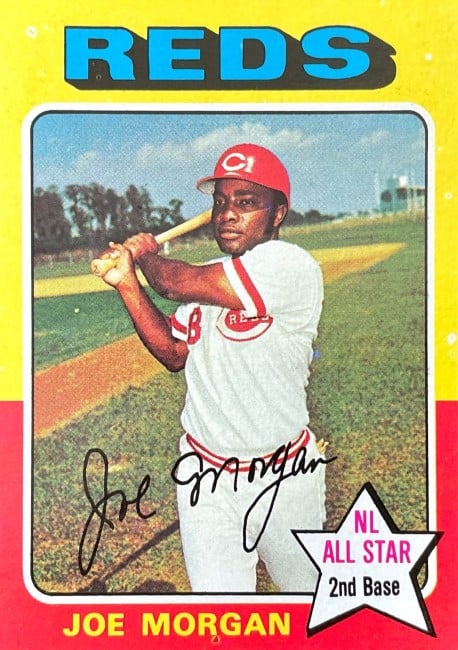
Player History
Joe Morgan, the diminutive second baseman nicknamed “Little Joe” or “The Little General,” wasn’t physically imposing, but his impact on the Cincinnati Reds was anything but small. From 1972 to 1979, he became the dynamic spark plug of the legendary “Big Red Machine,” a powerhouse dynasty that redefined baseball excellence.
Morgan began his career in Houston, and his arrival in Cincinnati in 1972 marked a turning point. Already a seasoned All-Star, he brought speed, on-base prowess, and clutch hitting to the Reds’ lineup. He led the league in walks and on-base percentage in his first season with the Reds, setting the tone for his offensive contributions to come.
Within the impressive Big Red Machine lineup, Morgan became transcendent. Alongside teammates like Johnny Bench and Pete Rose, the team was an unstoppable offensive juggernaut. Morgan earned back-to-back National League Most Valuable Player awards in 1975 and 1976, leading the Reds to consecutive World Series championships those years. His 1975 season was iconic, slashing .320 with 17 home runs, 94 RBIs, and an astounding 67 stolen bases. His on-field hustle and leadership were legendary.
Morgan’s consistency was also remarkable. He made eight consecutive All-Star appearances with the Reds and retired with a .271 batting average, over 2,500 hits and 689 stolen bases, etching his name among the best second basemen in baseball history.
Joe Morgan’s time with the Cincinnati Reds wasn’t just about individual accolades; it was about redefining an era of baseball. He was the spark plug that ignited the Big Red Machine, a champion, and a beloved figure forever etched in the hearts of Reds fans.
Joe Morgan was elected to the National Baseball Hall of Fame in 1990.
Best Cincinnati Reds baseball card: 1975 Topps Joe Morgan #417 (RC)
This vibrant red and yellow offering was released in 1975, before the first of Morgan’s two MVP campaigns. For collectors who want one of Morgan’s Cincinnati Reds cards, this is a notable choice. A few gem-mint PSA 10s exist, which have sold for around $2,700. In lower grades, the card is much more affordable (around $50-$150).
5. Frank Robinson
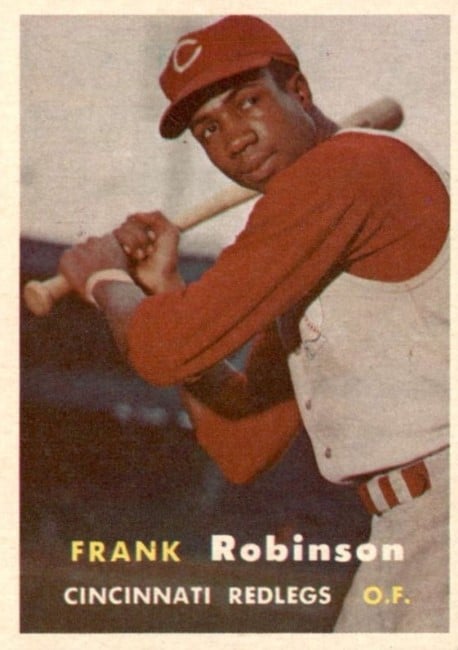
Player History
Frank Robinson’s 10 seasons (1956-1965) with the Cincinnati Reds were a period of individual brilliance in the days before the Big Red Machine. Stepping onto the field at 20 years old, he immediately made an impact, leading the team in home runs by mid-season. His play earned an All-Star nod and the Rookie of the Year award. The Reds, coming off 11 straight losing seasons, surprised everyone by contending for the pennant that year, ultimately falling just two games short.
Robinson’s power continued to be his calling card. He led the National League in homers in 1962, the same year he won his first National League MVP award. He consistently drove in runs, averaging over 100 RBIs per season from 1961 to 1965. Despite his individual success, the Reds never quite managed to reach the World Series during his tenure.
In 1965, however, the Reds traded Robinson to the Baltimore Orioles in a controversial move. A decade later, he became the first Black manager in Major League history. Said writer Tom Friend, of Robinson’s drive to succeed: “He had so much fire in him. He was Rookie of the Year in 1956 and NL MVP in 1961, but the scouting reports all said plays with a chip on his shoulder.”
Frank Robinson was elected to the Hall of Fame in 1982.
Best Cincinnati Reds baseball card: 1957 Topps Frank Robinson #35 (RC)
This is Frank Robinson’s highly sought-after Cincinnati Redlegs rookie card, released after his age 20 Rookie of the Year campaign. The card is in Topps 50s style, focused on photography and few graphical elements on the card. There are no known PSA 10s, but PSA 9s have sold for approximately $40,000. If your budget is under $1,000, look for PSA 6 examples, or below.
4. Barry Larkin
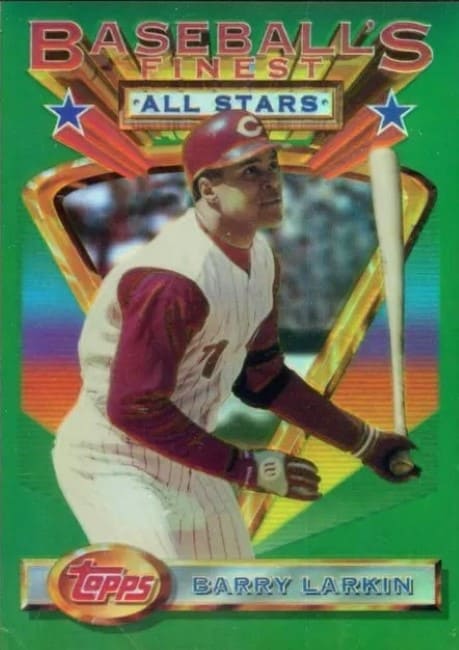
Player History
Barry Larkin donned the iconic red Cincinnati Reds uniform for his entire 19-year career. From 1986 to 2004, he was a cornerstone of the Reds, captivating fans with his defensive wizardry, offensive prowess, and leadership both on and off the field.
Larkin’s stats speak volumes. He has a career batting average of .295 and he has amassed 2,340 hits, 198 home runs, and 379 stolen bases, ranking 12th all-time among shortstops. He also won nine Silver Slugger awards, the most among shortstops.
Beyond individual accolades, Larkin was a vital piece of the Reds’ success. He was named an All-Star a remarkable 12 times and was the heart and soul of the team during their competitive years in the late 1980s and early 1990s. In 1990, he emerged as the National League MVP, batting .301 and leading the league in stolen bases. That season, the Cincinnati Reds won their fifth (and so far final) World Series championship. Today, he is considered one of the greatest shortstops to ever grace the diamond.
Larkin’s leadership extended beyond the field. He was deeply involved in his community, earning the Roberto Clemente Award in 1993 for his philanthropic efforts.
Barry Larkin was inducted into the National Baseball Hall of Fame in 2012.
Best Cincinnati Reds baseball card: 1993 Topps Finest Refractor Barry Larkin #114
Larkin, despite his excellence, was not highly collected and doesn’t appear in many rare sets from his playing years. Playing in the late 80s-90s, his rarest card is the 1993 Topps Finest refractor, which is unnumbered but rumored to be limited to 250 copies. The set famously features the hobby’s first refractors. The card costs around $250-$300 in ungraded condition, but ultra-rare PSA 10s can cost thousands.
3. Joey Votto
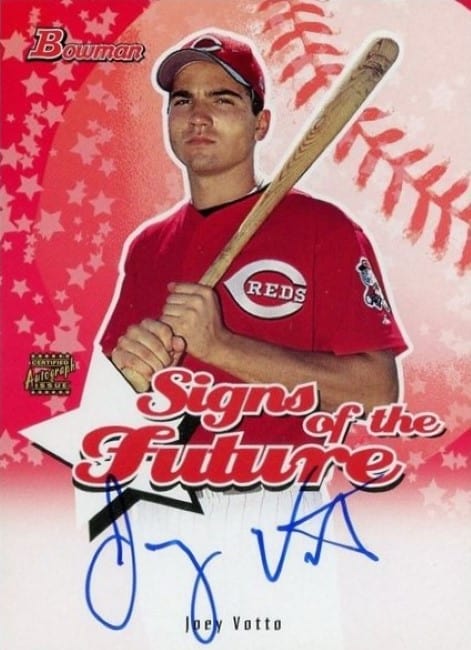
Player History
Joey Votto, a stalwart presence in the Cincinnati Reds lineup for 16 seasons and counting, has carved his own niche in the team’s storied history. Donning the red pinstripes since 2007, Votto has established himself as one of the league’s most consistent and talented hitters, while also capturing the hearts of Reds fans with his unique personality and dedication to the city.
Votto’s offensive prowess is undeniable. As of the 2023 season, he boasts a career batting average of .297, amassing 2,135 hits, 345 home runs, and 1,114 RBIs. His on-base percentage, consistently ranking among the league’s best, has earned him the nickname “Joey Bats.” He’s a six-time All-Star, a Gold Glove Award winner, and the 2010 National League MVP, recognized for his exceptional plate discipline and ability to hit for both average and power.
From his patient plate discipline to his viral TikTok videos, Votto brings a refreshing perspective to the game, captivating audiences with his unconventional yet undeniably effective style. Whether he continues to add chapters to his Reds’ story or not, Joey Votto has cemented his place as a modern-day baseball legend.
Best Cincinnati Reds baseball card: 2004 Bowman Signs of the Future Joey Votto Autograph #SOFJV
Joey Votto’s rookie card situation is complicated, so we’ll (mostly) steer clear of it by choosing this gem from 2004. This is Votto’s first certified autograph, and falls between in 2002 “true” rookie year and his major league debut in 2008. The card is priced around $300-$400 for a near-mint example.
2. Johnny Bench
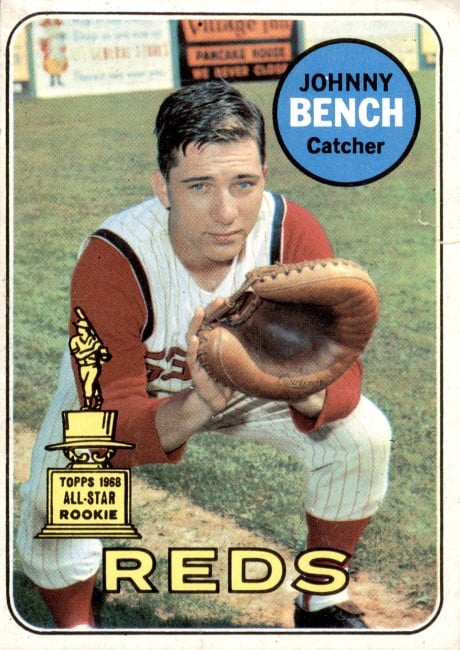
Player History
Johnny Bench, the man they called “The Big Red Machine’s Engine,” wasn’t just a Cincinnati Reds player; he was the heart and soul of the franchise during its dominant era. For 17 seasons, from 1967 to 1983, Bench redefined the catcher position not just for the Reds, but for all of baseball.
In 1967, he won Rookie of the Year, along with his first of 10 consecutive Gold Gloves and the first of 13 straight All-Star appearances (and 14 total). His Gold Glove tally is second all-time among catchers. But Bench wasn’t just a defensive wizard. At the plate, he amassed 389 home runs, a record for catchers at the time, and drove in 1,376 runs.
Beyond the stats, Bench was a leader. He captained the “Big Red Machine” to six division titles, four National League pennants, and two World Series championships in the 1970s, solidifying his legacy as one of the greatest winners in baseball history.
Said Bench of his achievements: “They only delivered the newspaper once a week where I lived in Oklahoma, and those people lived and died with the box score of my games. My biggest moment was winning the World Series because everyone in my town was able to feel he was a world champion.”
Johnny Bench was inducted into the Baseball Hall of Fame in 1989.
Best Cincinnati Reds baseball card: 1969 Topps All-Star Rookie Johnny Bench #95 (RC)
Bench’s true rookie came out in 1968, but he shared the card with Ron Tompkins. His first solo card celebrates his Rookie of the Year award and the first of many All-Star game appearances, and is a worthy card in its own right. The design and coloring are crisp, and Bench’s Reds uniform pops against the green grass as he crouches in his catching position. For a high grade, expect to pay $500-$1,000 for this card, or around $50 for mid-grade and ungraded versions.
1. Pete Rose
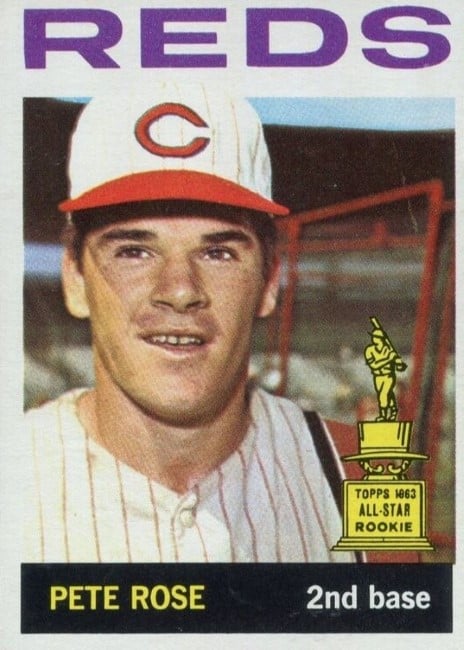
Player History
Pete Rose, baseball’s “Hit King,” wore the Cincinnati Reds pinstripes for 23 of his record-breaking 24 seasons, becoming synonymous with the team and the city he called home. While his legacy remains complex due to his gambling ban, his on-field achievements for the Reds are undeniable.
From 1963 to 1986, Rose established himself as a relentless offensive force. He holds the MLB record for most career hits with 4,256. He holds Reds records for games played, at bats, total bases, runs scored and WAR (among others).
Beyond individual accolades, Rose played a key role in the Reds’ golden age. He was a vital cog in the “Big Red Machine” dynasty of the 1970s, winning two World Series championships and three National League pennants.
As a player, Rose’s blue-collar work ethic and passion for the game resonated with many. He was known for his hard-nosed style of playing – earning the nickname “Charlie Hustle” – as he would frequently barrel into opponents in pursuit of runs. Rose later went on to manage the Reds from 1984 to 1989.
Despite his on-field brilliance, Rose’s career ended on a controversial note. In 1989, he was banned from baseball for betting on games, tarnishing his image and leaving a complex legacy.
Whether viewed as a fallen hero or a flawed legend, Rose’s impact on the Cincinnati Reds and baseball as a whole remains undeniable. He holds the MLB record for most hits, a seemingly untouchable feat, and his name remains deeply woven into the fabric of the Reds’ history.
Best Cincinnati Reds baseball card: 1964 Topps Pete Rose All-Star Rookie Card #125 (RC)
Like many rookies of the 1960s-1980s, Pete Rose shares his rookie card with three other players. That makes his second year card more desirable for many fans. And what’s not to like? The white border makes the colors pop, and the close-up pose is crisp and engaging. PSA 9s sell in five figures, but a mid-grade version of the card is priced around $500.
